On our recent trip to Moab, we walked into our hotel room and saw photos on the wall of these bright blue pools in Moab. I had to figure out where the potash ponds in Moab, Utah, were located so we could go see them. In the process, I ended up learning all about the Moab potash ponds.
If you look at Google Earth, you can see the potash ponds in Moab appearing in purples and pinks. There are a few places to go to see the potash ponds in Moab, but some are better than others. Besides explaining what the potash ponds are, this post covers where to see the potash ponds and tips for viewing them as well.
Looking for more Utah travel tips? Don’t miss other unique spots in Utah like the Bentonite Hills near Capitol Reef or the Great Chamber near Kanab. Cross over into Northern Arizona to visit a Wave alternative called White Pocket too.
***Some of the links in this post are affiliate links meaning we earn a small commission at no extra cost to you.
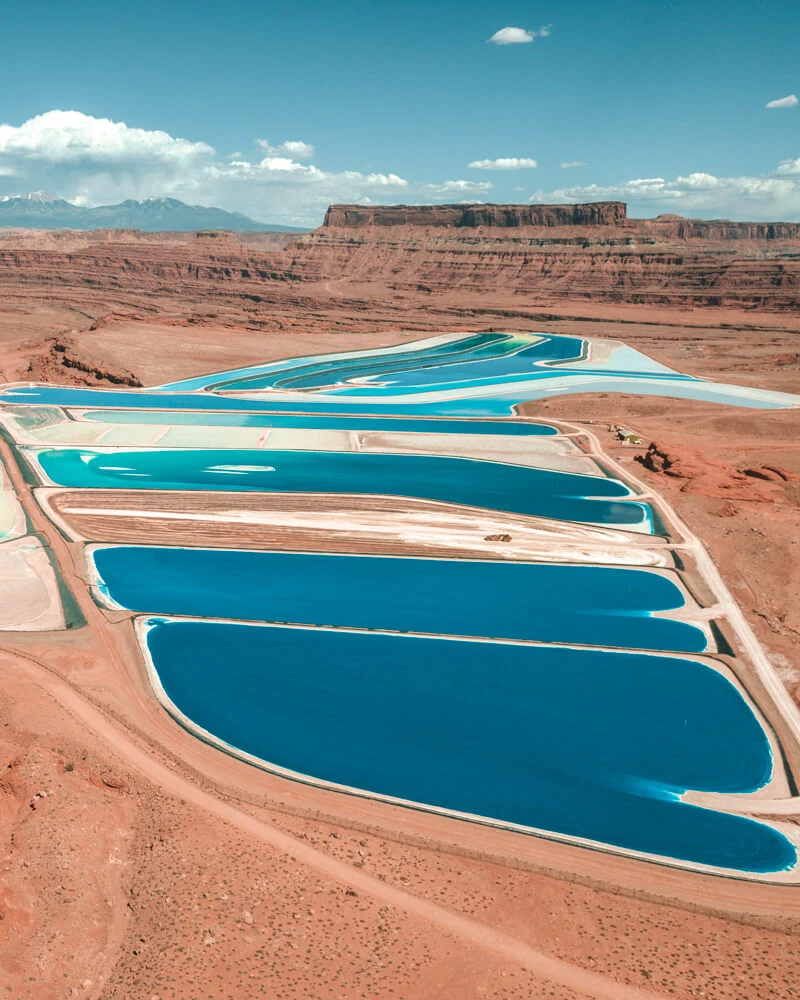
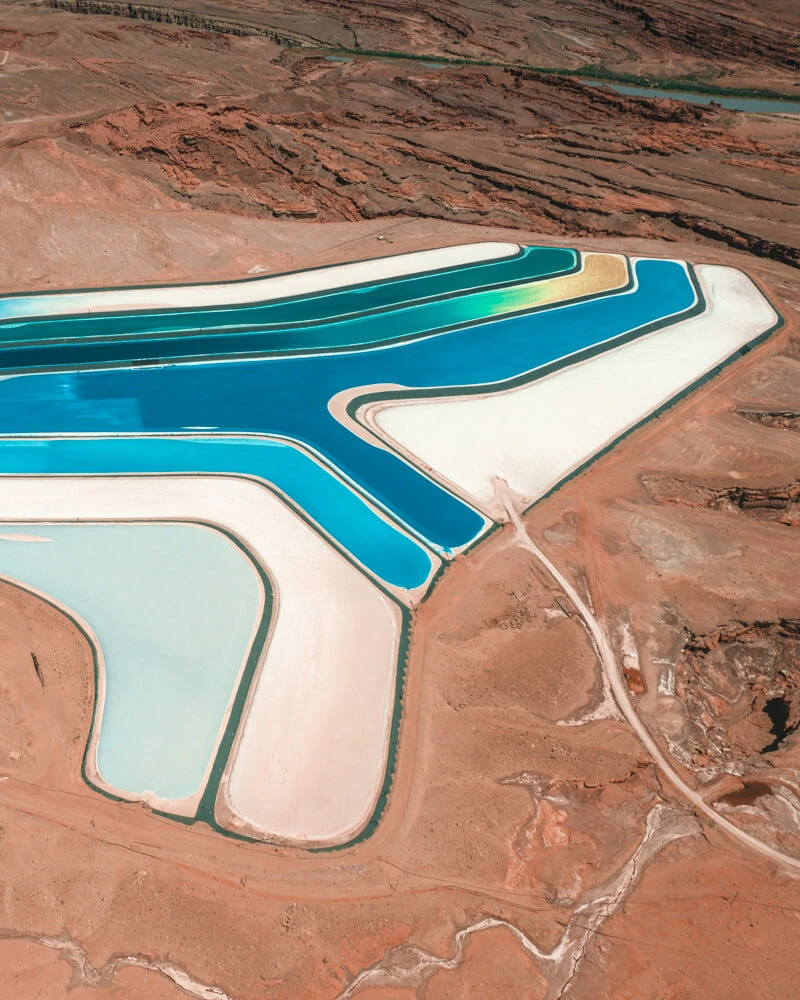
Table of Contents
What are the Blue Ponds in Moab Called?
The blue ponds in Moab, Utah, are becoming more and more well known because of how the blue water stands out against the red and orange hues of the surrounding desert. These blue ponds are called potash ponds or potash evaporation ponds. They show up on Google Maps as the Texas Gulf Potash Ponds.
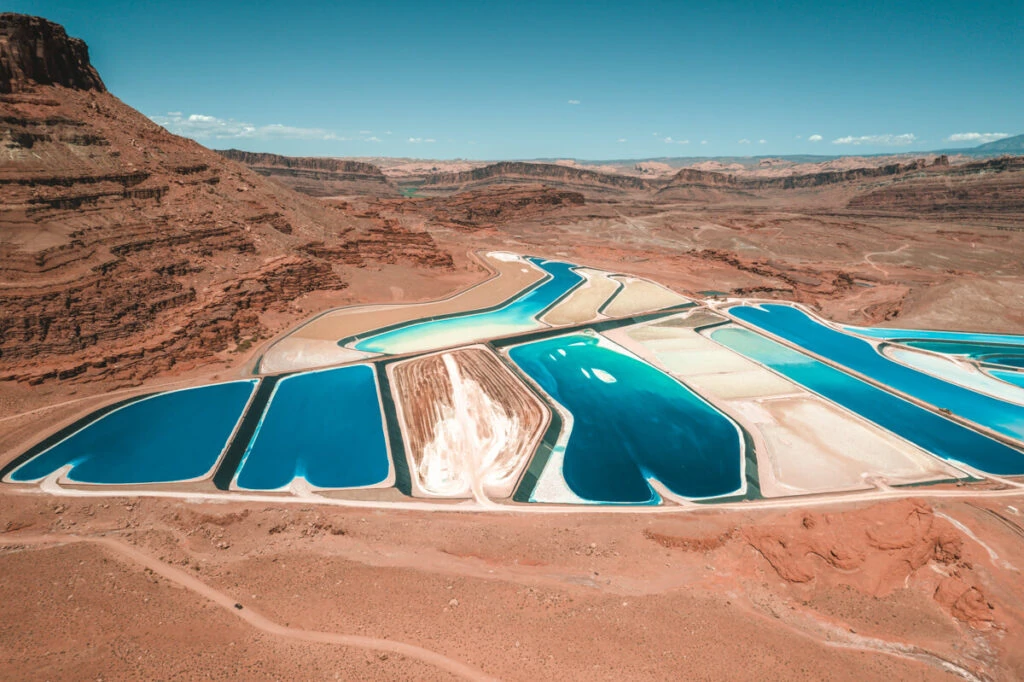
What are Potash Ponds in Utah?
The bright blue ponds are actually potash evaporation ponds owned by Intrepid Potash, Inc. They have three mines in the western United States with the potash ponds in Moab, Utah, being the most well-known. There are potash ponds in Carlsbad, New Mexico, but there are actually two potash ponds in Utah. The other, lesser-known ponds are located in Wendover, Utah.
Texas Gulf built the plant in the 1960s, but the system changed after an explosion trapped 25 miners, killing most of them. This is when they started using solution mining and solar evaporation, giving us the famous bright blue ponds.
Potash refers to several types of potassium salts including potassium chloride (KCl). While it is mostly used in fertilizer in the United States, it can also be used in glass, ceramics, soap, and batteries.
The potash mine is over 3,000 feet below the ground. They pump in water from the Colorado River to create a brine. Then they pump the brine up into the evaporation ponds once it becomes heavily concentrated.
Once the water evaporates, the potash from each Texas Gulf potash pond is harvested. Once harvested, Intrepid Potash uses it in fertilizer that is used across the United States. The Utah Geological Survey goes into much more detail for anyone who wants to learn more about the process.
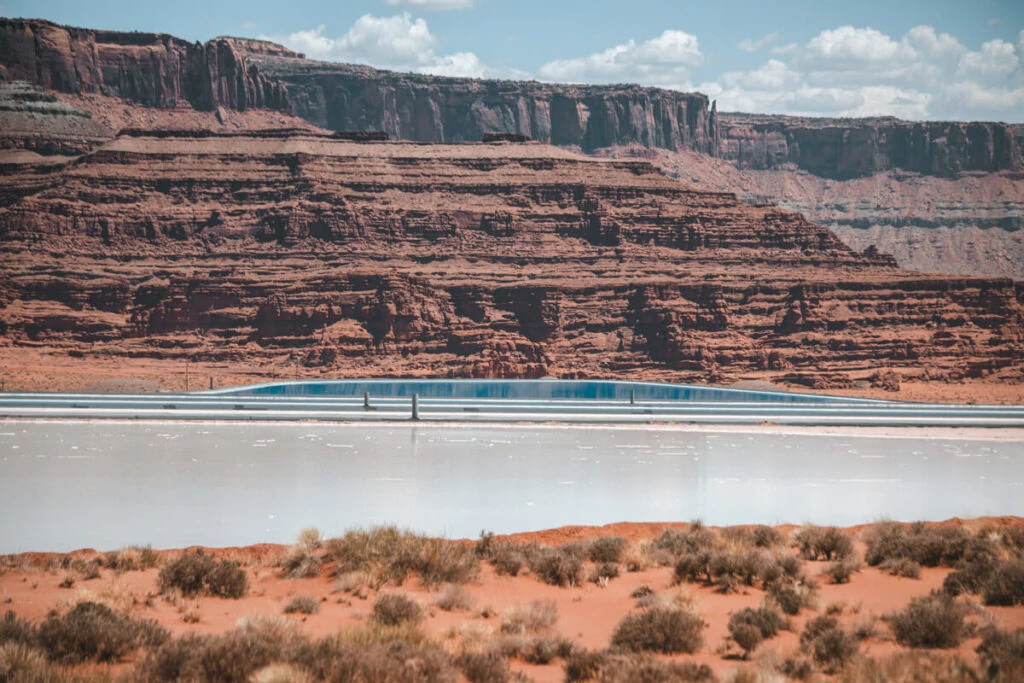
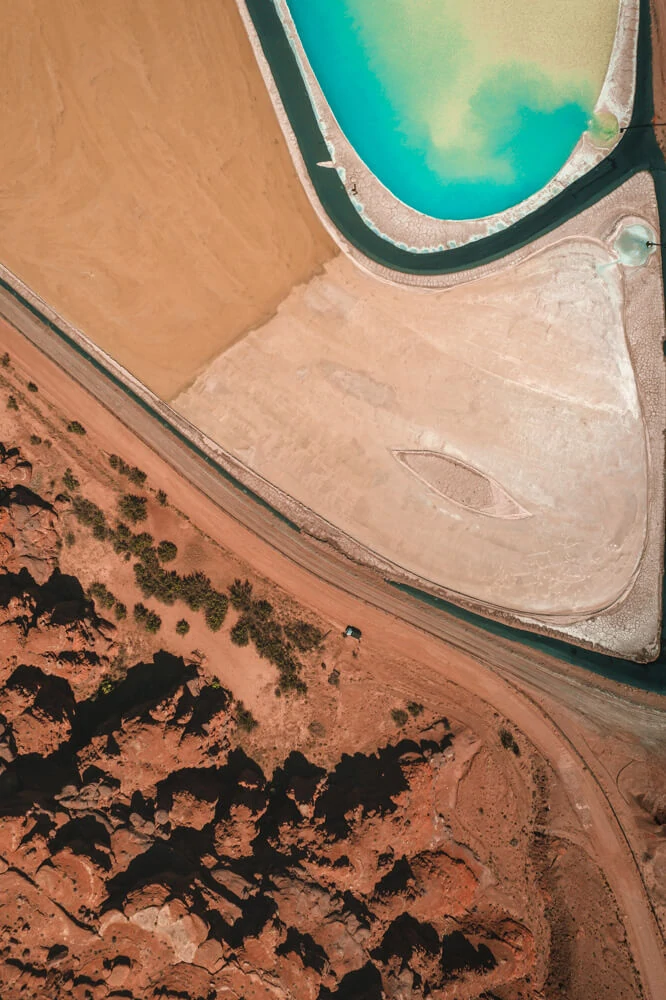

Why are Potash Ponds Blue?
The potash ponds are blue because of the blue dye they add to the brine. This dye helps speed up evaporation as it increases the absorption of sunlight. The darker water absorbs more sunlight and heat allowing them to harvest the potash faster and start the process over again.
The ponds are not always bright blue. The process takes about 300 days, and the ponds go through a variety of colors during the process. Soon after they add the dye, you see the bright blue color. As the evaporation process takes place, the ponds turn lighter blue. The ponds eventually turn more of a tan or brown color after almost all of the water evaporates, leaving the potash at the bottom of the pond for collection.
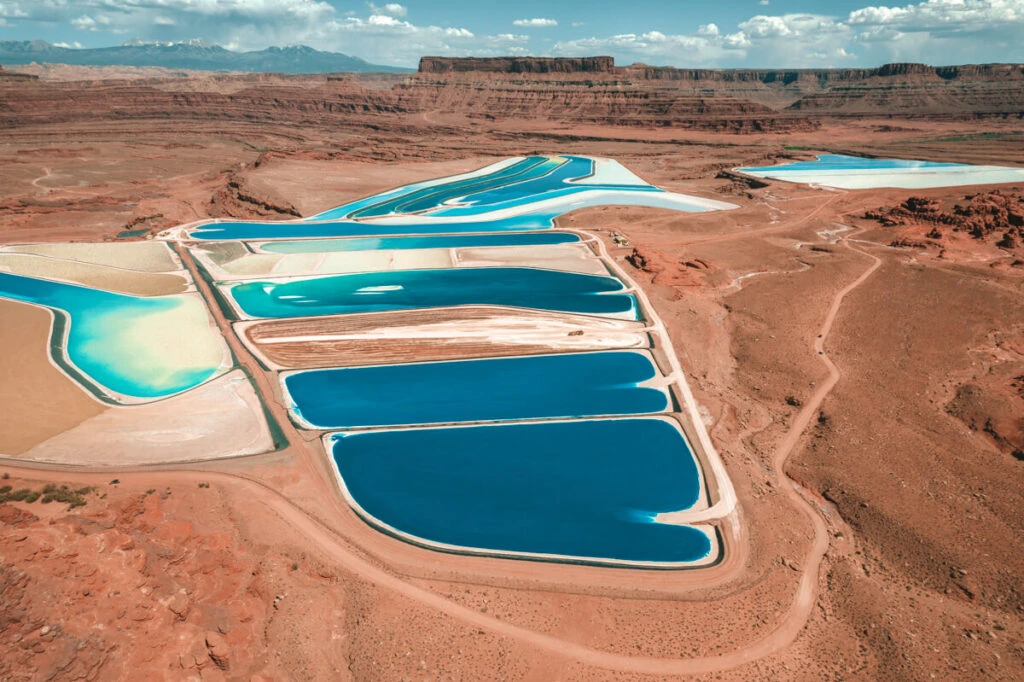
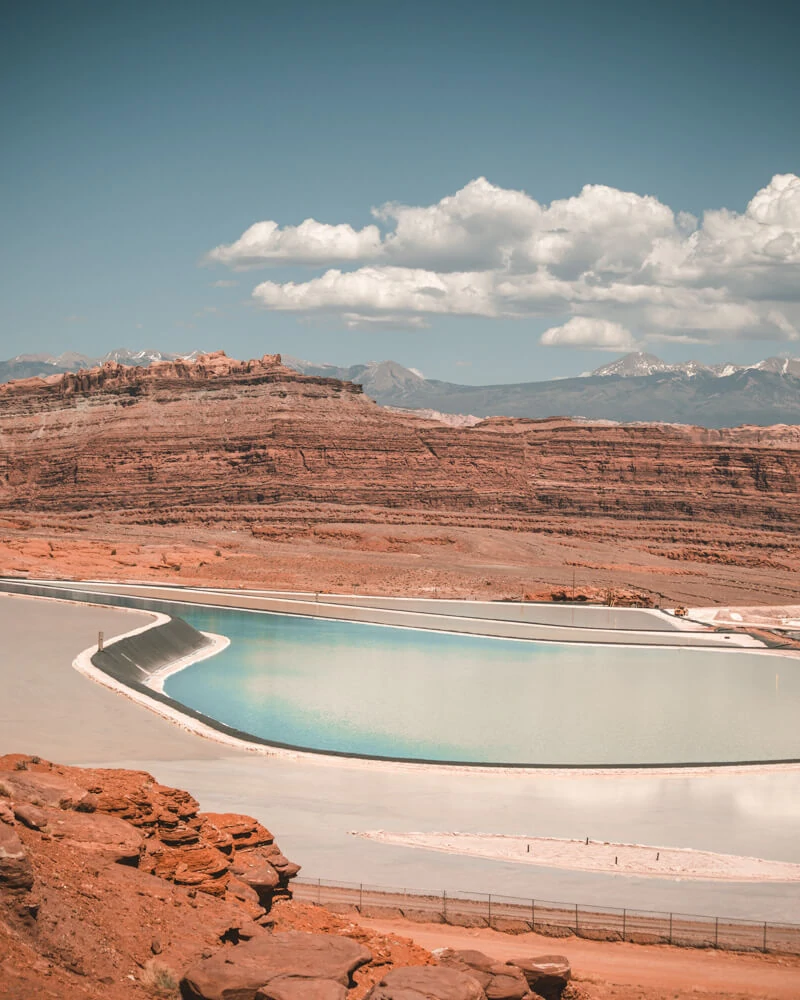
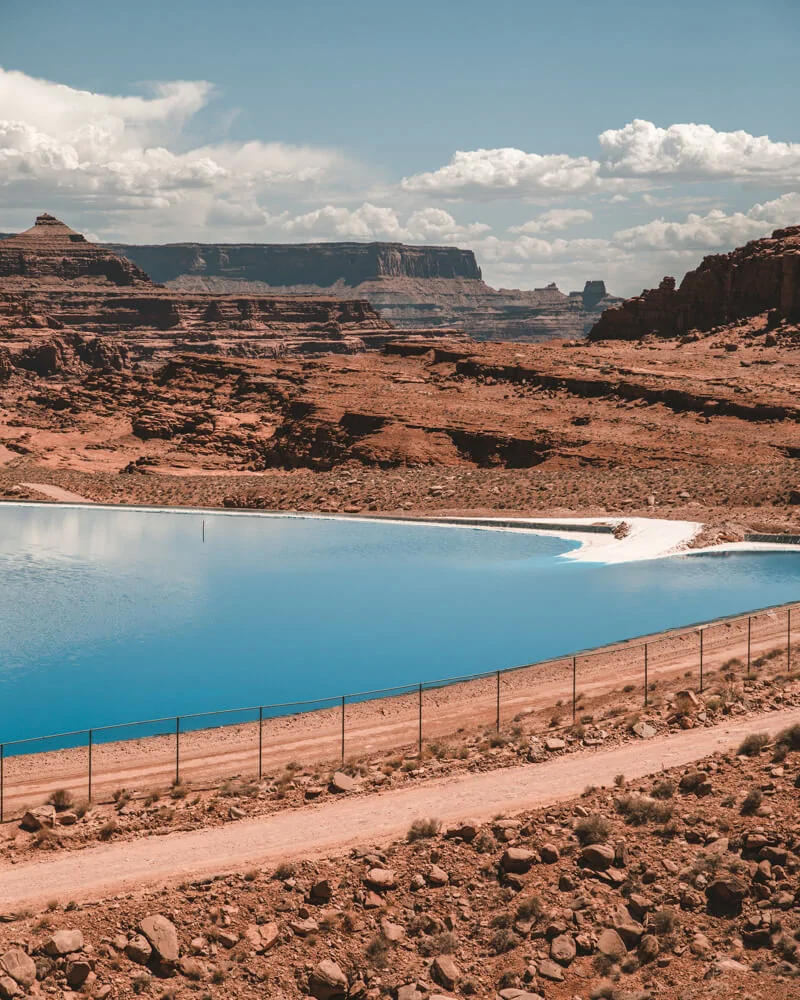
Best Time to Visit the Potash Evaporation Ponds
If you want to see the ponds when the colors are the brightest, your best chance is in the summer. We visited in late May, and most of the ponds were still a bright blue color.
The summer months are when evaporation is most intense with the long sunny days, so that is the best chance to see the famous bright blue ponds of Moab, Utah. You can still view them at other times of the year, but the colors may not be as intense.
Because Moab gets crazy hot in the summer, you may want to visit earlier in the day or later in the evening when the weather isn’t quite as warm. We visited in the middle of the day, and it was hot. I worried the sunlight would drown out the colors for photos of the potash ponds, but that did not happen.
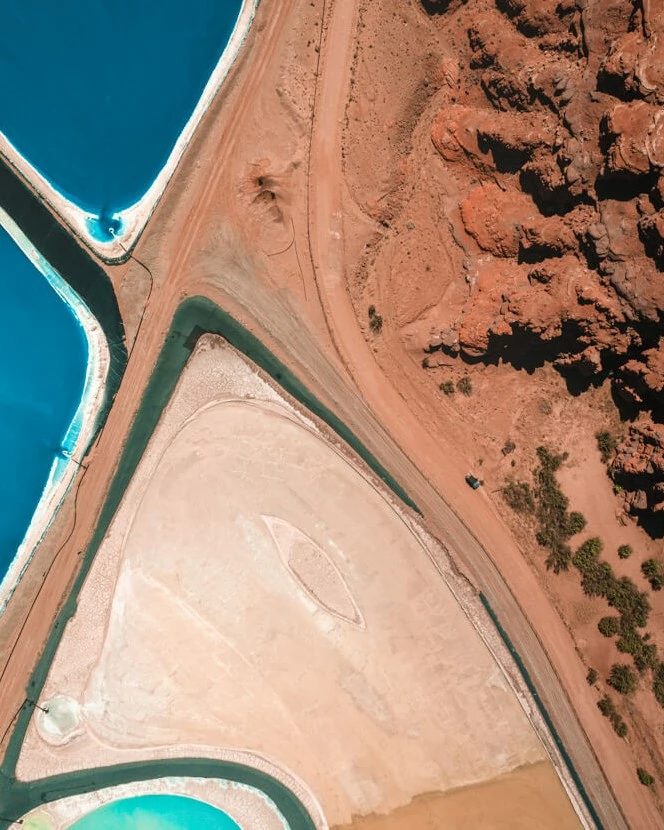
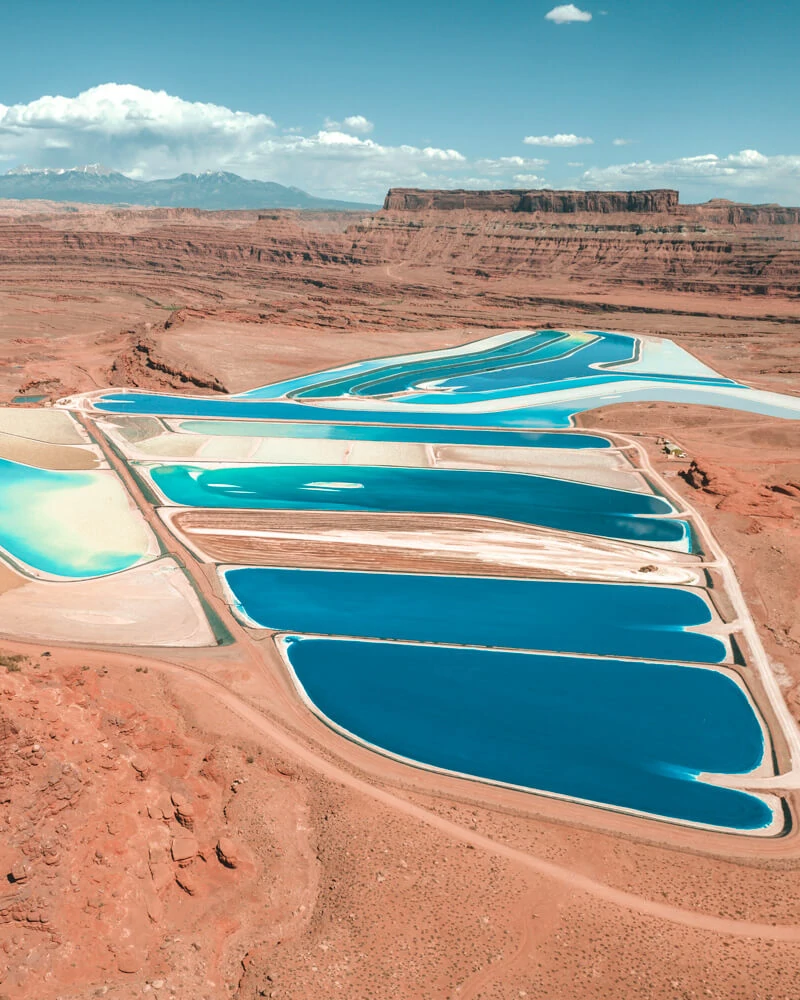
How to See the Potash Ponds in Moab
We wanted to find out if we could visit the potash ponds, so I started doing a little bit of research. I could not find much about where to see them other than road names. Note that the potash ponds are on private property, so you would need to check with Intrepid Potash before trying to enter the private property to view the potash ponds (we did not even attempt this).
The potash ponds are located between Arches National Park and Dead Horse Point State Park and Canyonlands State Park near the Colorado River. They are an easy drive from the city of Moab, Utah (unless you choose Chicken Corners which is NOT an easy drive!).
Here are the best places to see the Moab potash ponds:
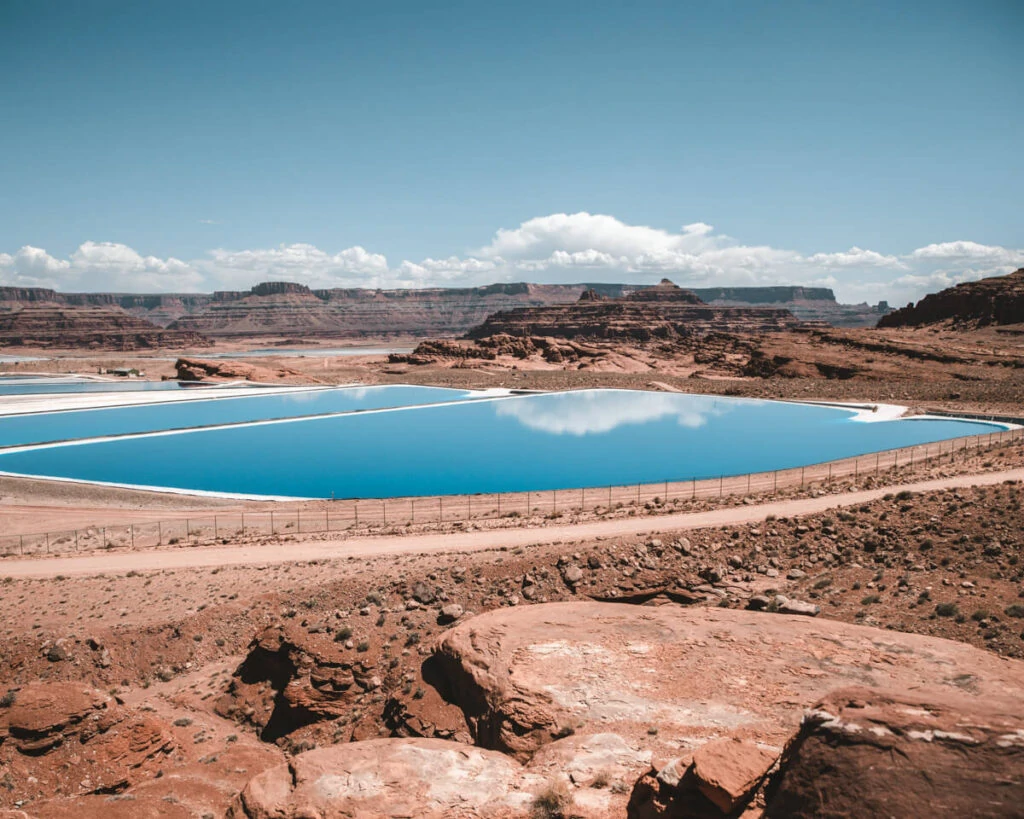
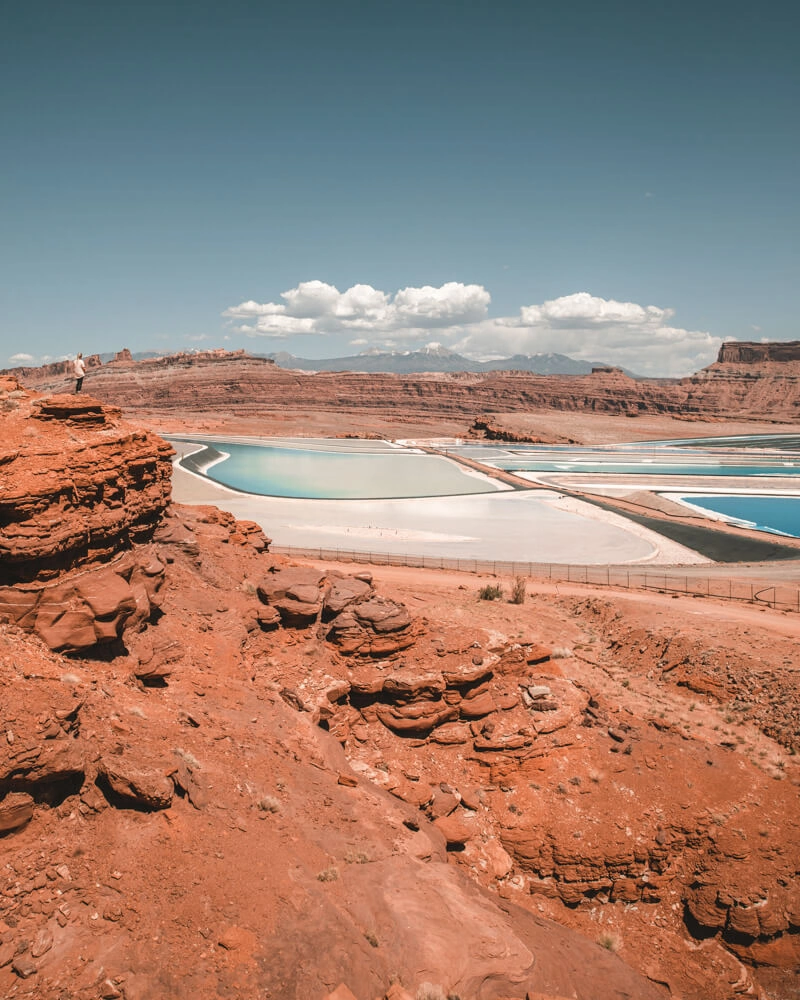
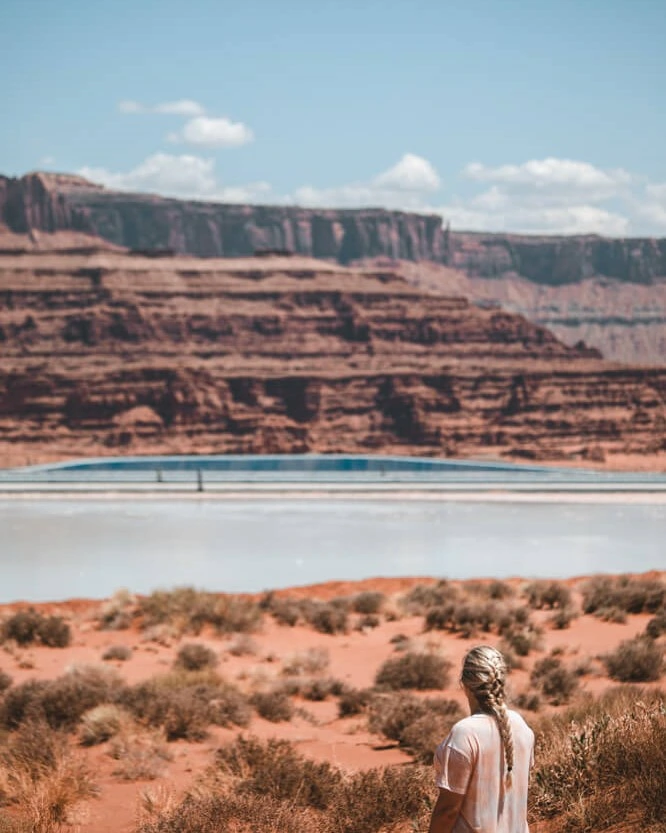
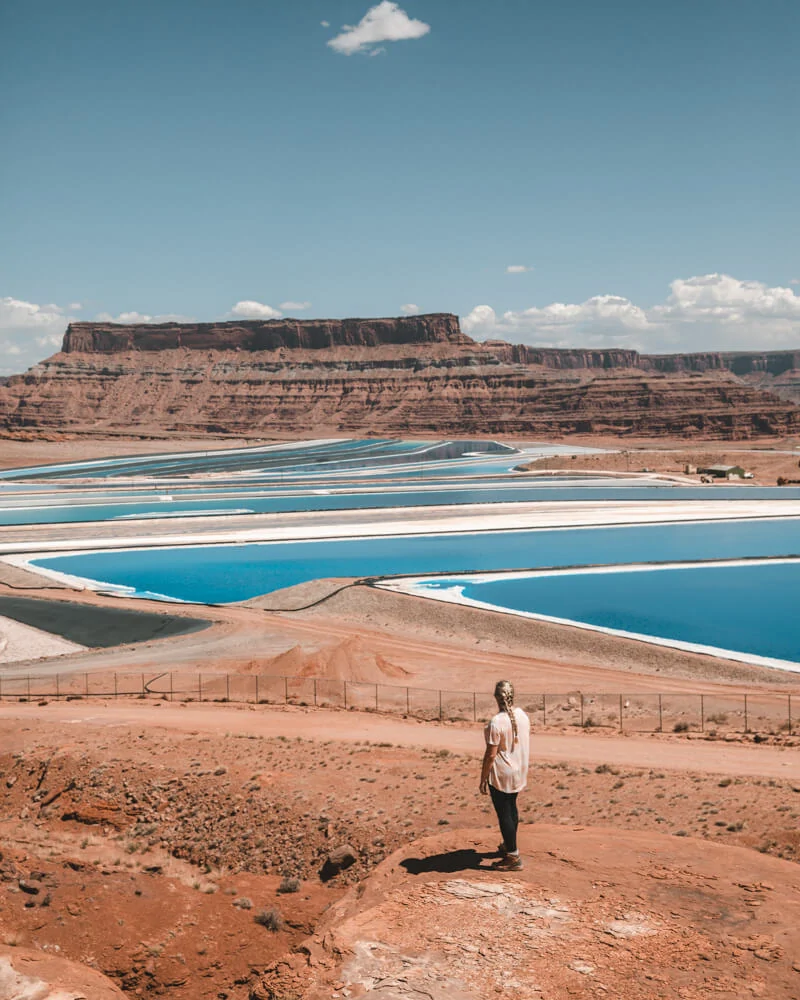
Dead Horse Point State Park
You can see the potash ponds from Dead Horse Point State Park. If you are going to head to Dead Horse for sunset or to view the canyon from there, keep your eyes open for the blue ponds. It is definitely worth a trip to Dead Horse Point State Park, even if you don’t look for the potash ponds.
The best part of this view of the ponds is that you do not need a 4-wheel drive vehicle. Any vehicle can reach Dead Horse Point State Park, and then you can walk out to view the ponds from there. The other two options on this list do require 4-wheel drive high clearance vehicles.

Potash Road or Potash Scenic Byway
This was my favorite view of the potash ponds. We were able to get the best photos and the closest to the potash ponds here. State Route 279, also known as Potash Road or Potash Scenic Byway, follows the Colorado River and goes right along the potash ponds.
If you take this route, you can also stop to see Elvis Rock on the way. Make sure to stay on the main road though. Many of the roads near the potash ponds are private property owned by Intrepid Potash and are not open to the public.
This road does require 4-wheel drive and a high clearance vehicle. A 2-wheel drive high clearance vehicle may be able to make it when the road is dry. The road is rough in some parts and would likely be impassable when wet to all vehicles. A low clearance vehicle might bottom out on some of the rocks and potholes.
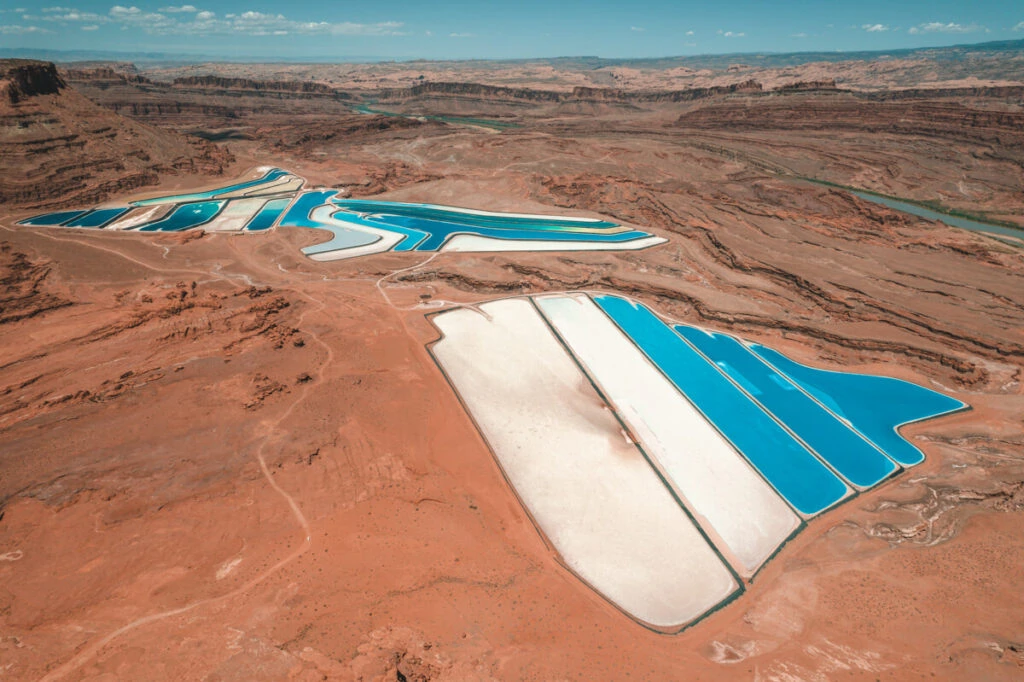

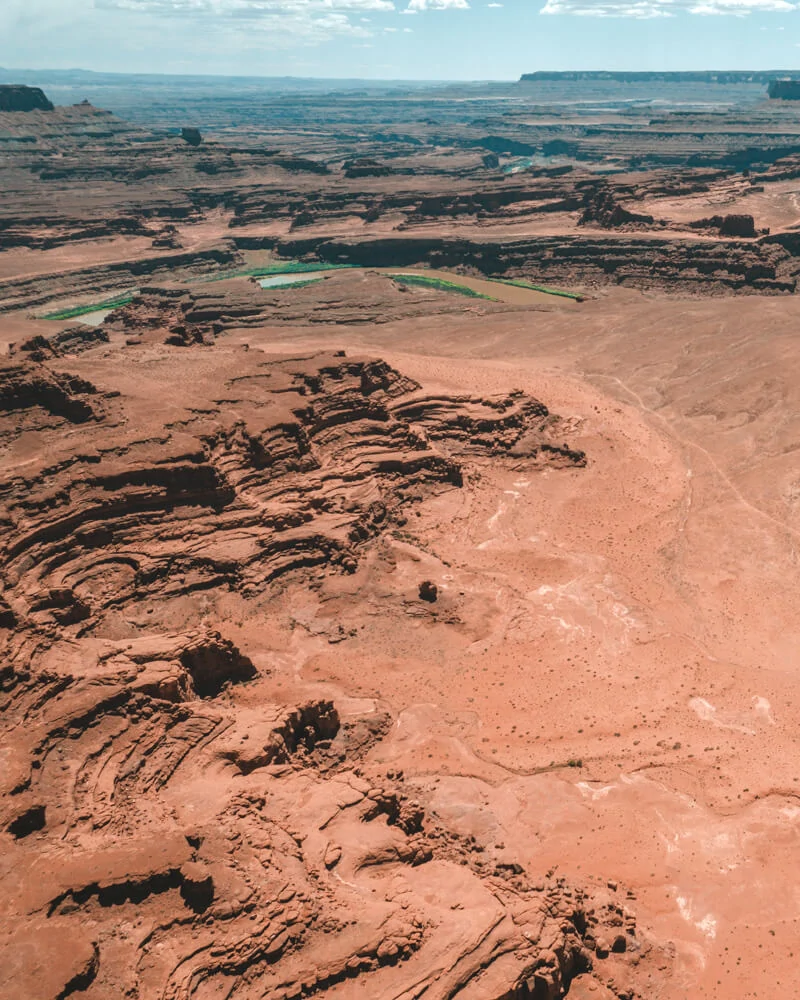
There are no facilities once you start on the dirt road. Make sure to bring water (and food) and to stop for the bathroom before you head this way.
To get to this point in Google Maps, you can put in Elvis Rock. Stop for a quick photo and then continue past Elvis Rock to see the potash ponds. You can also put in these coordinates, but keep driving past them for more views: (38.4900109, -109.6931025).
There is a fence along the road to keep people out of the ponds. Make sure to stay on the other side of the road, and use this interactive map to make sure you are on BLM land and not private property.
Be respectful of the property lines and do not attempt to climb the fence for a photo or to get closer to the potash ponds. You can climb up some of the rocks on the BLM land to get photos of the ponds without the fence in the way.
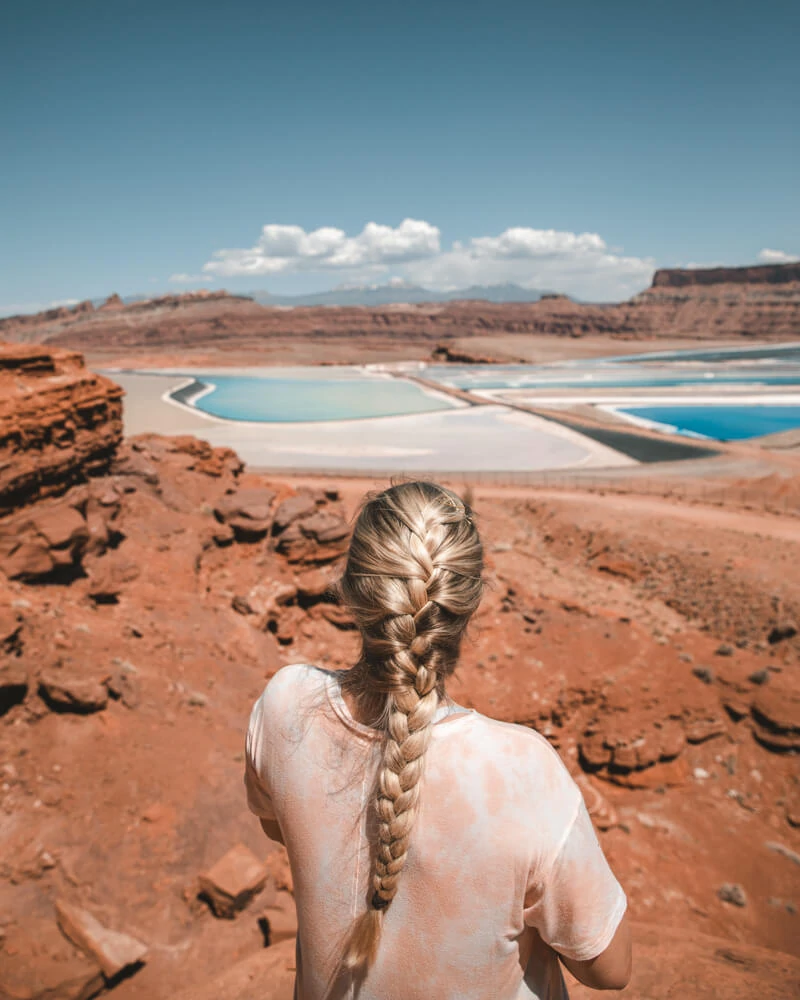
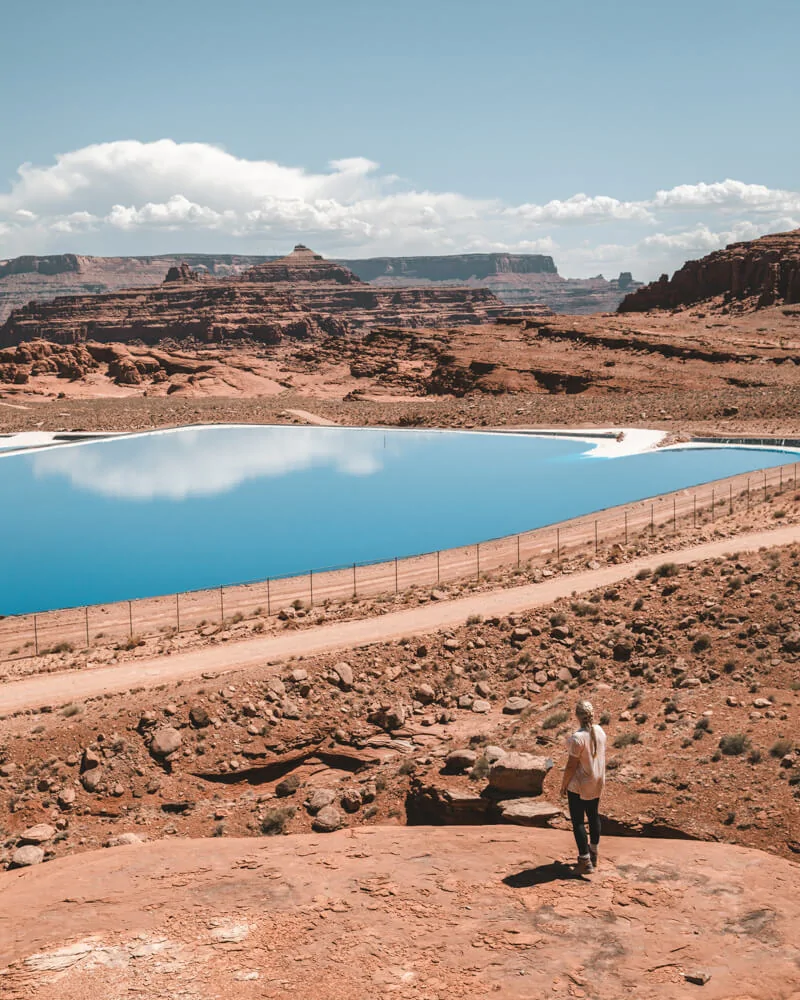
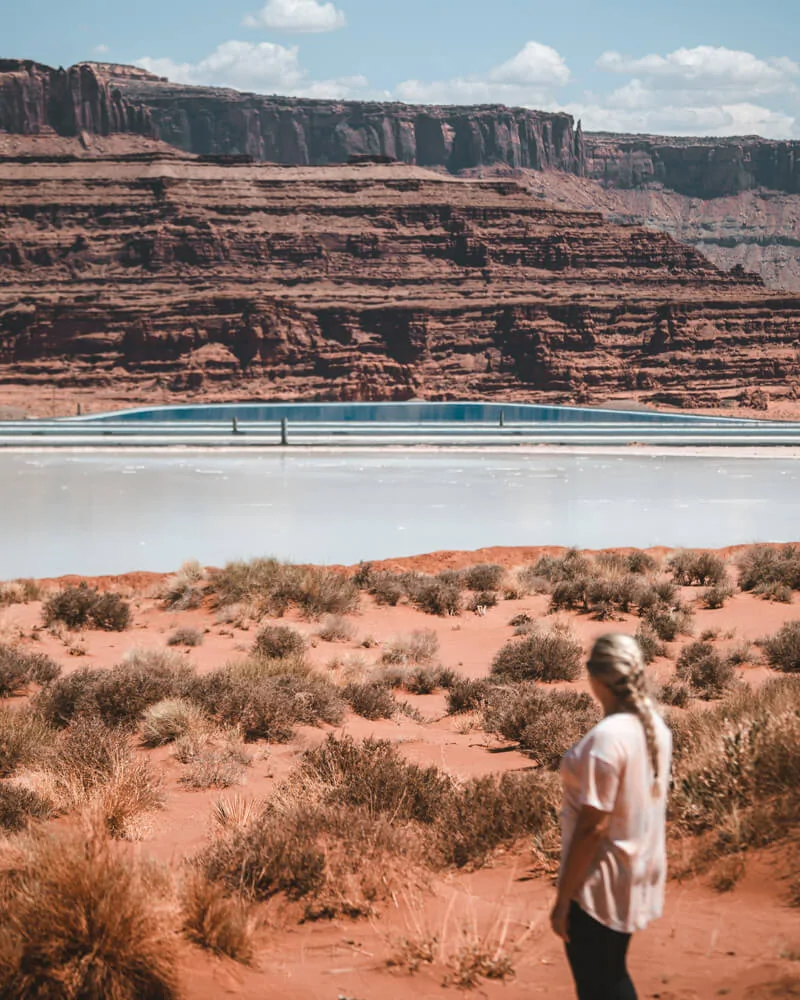
Chicken Corners OHV Trail
Another spot to see the potash ponds is from the Chicken Corners OHV trail. First of all, this one is not for the faint of heart. My poor husband had to deal with me sitting on the edge of a steep drop on the way into the canyon, and I did not handle it well.
I’m not scared of heights generally, but I did not like how close the tires had to be to the edge in some points. It was worse because I was on the passenger side overlooking the huge drop. This isn’t even one of the more intense OHV trails in Moab, but you can check my Instagram highlights under ’21 Utahx2 for an example of how I handled this trail. I did drive part of it on the way back up and handled the way out much better thankfully.
You will need a 4-wheel drive vehicle for this trail, and it needs to be a high clearance vehicle. You may want to have some experience driving on an OHV trail prior to attempting this one. While many of the technical climbs are easy to avoid, there are some more difficult sections. The trail gets much easier once you reach the lower section of the canyon.
If you are wanting to do an OHV trail in Moab, this is a pretty good one to do. The view of the potash ponds is not great though. They are fairly far off in the distance, so a phone camera won’t capture them well without a zoom. You would want a decent zoom lens to capture them on a camera too.
This was our first glimpse of the potash ponds. I thought at first that this view would be good enough, but we ended up deciding to try Potash Road after seeing how far away we were at Chicken Corners. I’m glad we did because that route was much better for seeing the most well-known of the potash ponds in Utah.
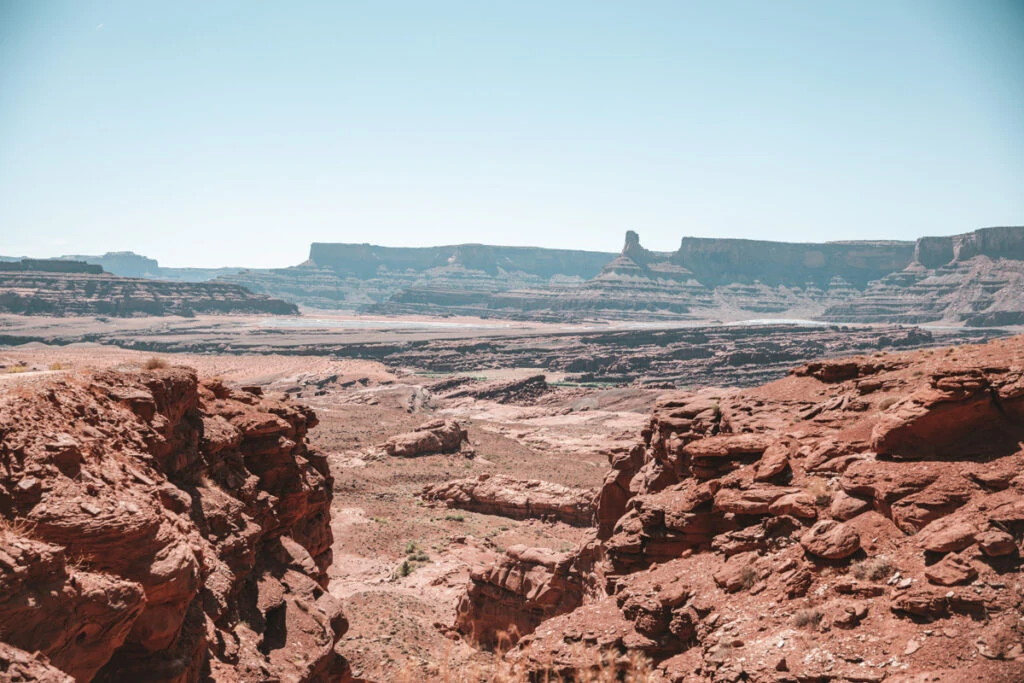
Tips for Seeing the Moab Potash Ponds
The potash ponds in Utah are one of the more off the beaten path spots in Moab. They are also one of the lesser known things to do in southern Utah although they are becoming more popular thanks to social media.
If you do decide to see the potash ponds, especially off of Potash Road, keep in mind that the area is private property and that work is going on constantly. While we were viewing the ponds from Potash Road, they were harvesting the potash from one of the ponds.
We saw a good amount of traffic on the dirt road by the potash ponds, so be careful. Keep an eye out as you cross the road or stop to take pictures. Try to use one of the areas to pull off the road so that you are not blocking other vehicles.
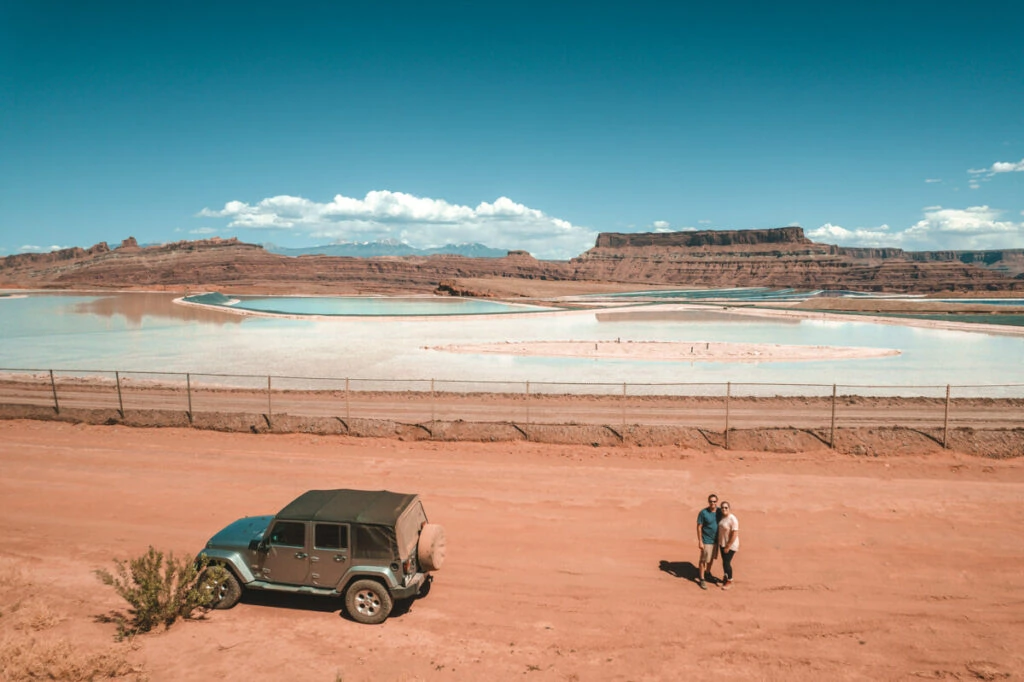
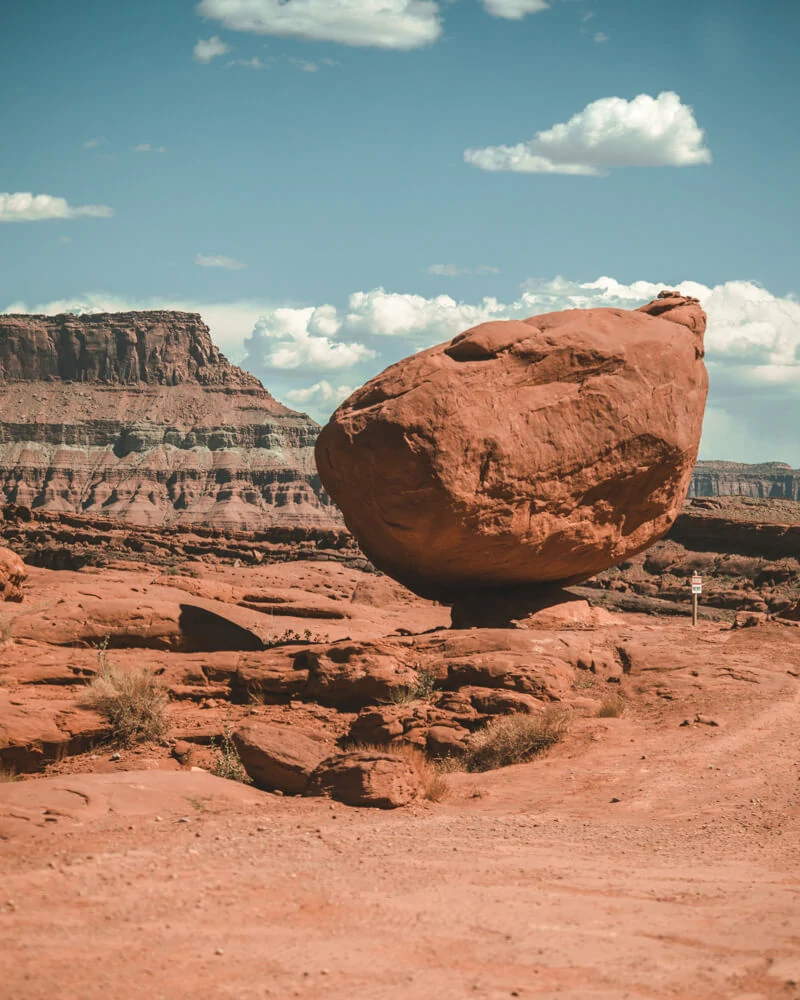
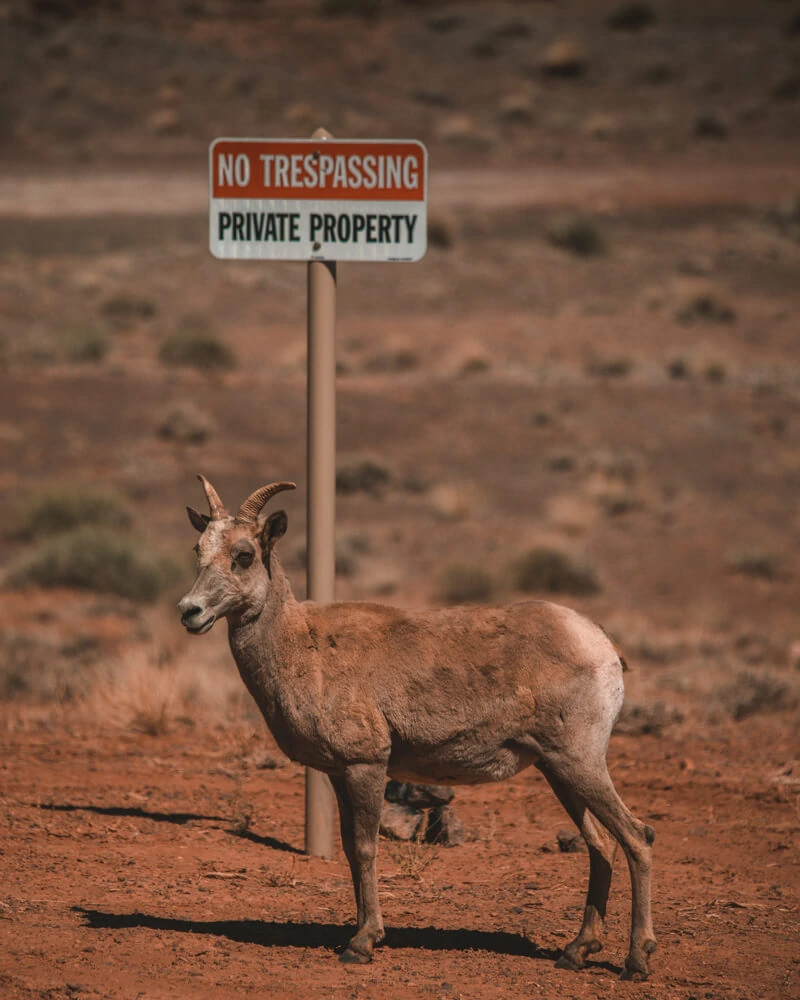
Flying a Drone at the Potash Ponds
Before flying our drone at the potash ponds, we did two things. First, we looked at the BLM interactive map we used for most of the trip to see who controlled the land surrounding the potash ponds. We also called the BLM office in Moab and spoke to one of the rangers to confirm drones were allowed.
The map shows you the boundaries of the private property and the BLM land. Drones are not allowed over the private property unless you have permission, so make sure to keep your drone on the BLM land and not over the ponds or private property.
The ranger we spoke to told us we would need to check with Intrepid Potash before flying the drone over the ponds. We decided not to bother after looking for contact information for a few minutes. We ended up being able to get good photos without needing to fly over the ponds.
Here’s a little drone video of the potash ponds from my Instagram:
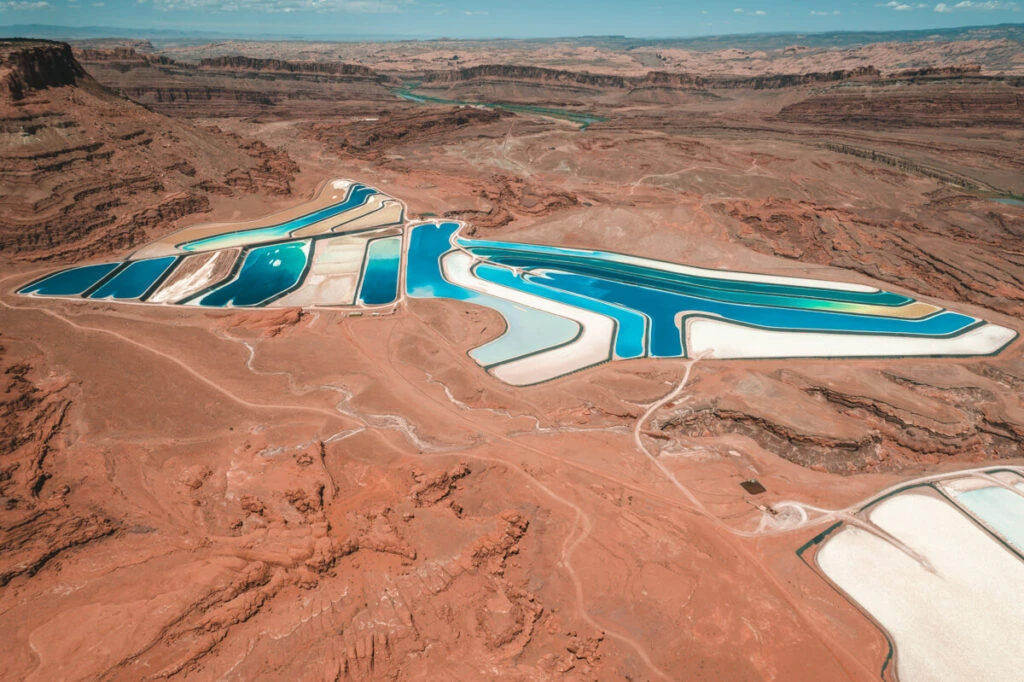
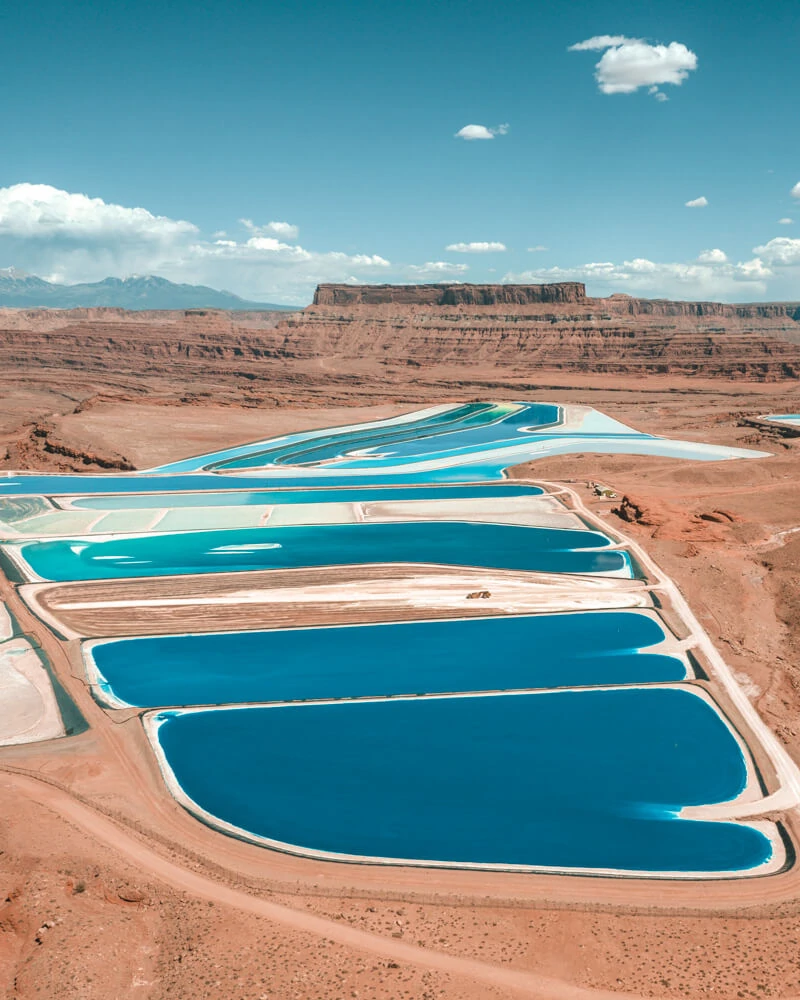
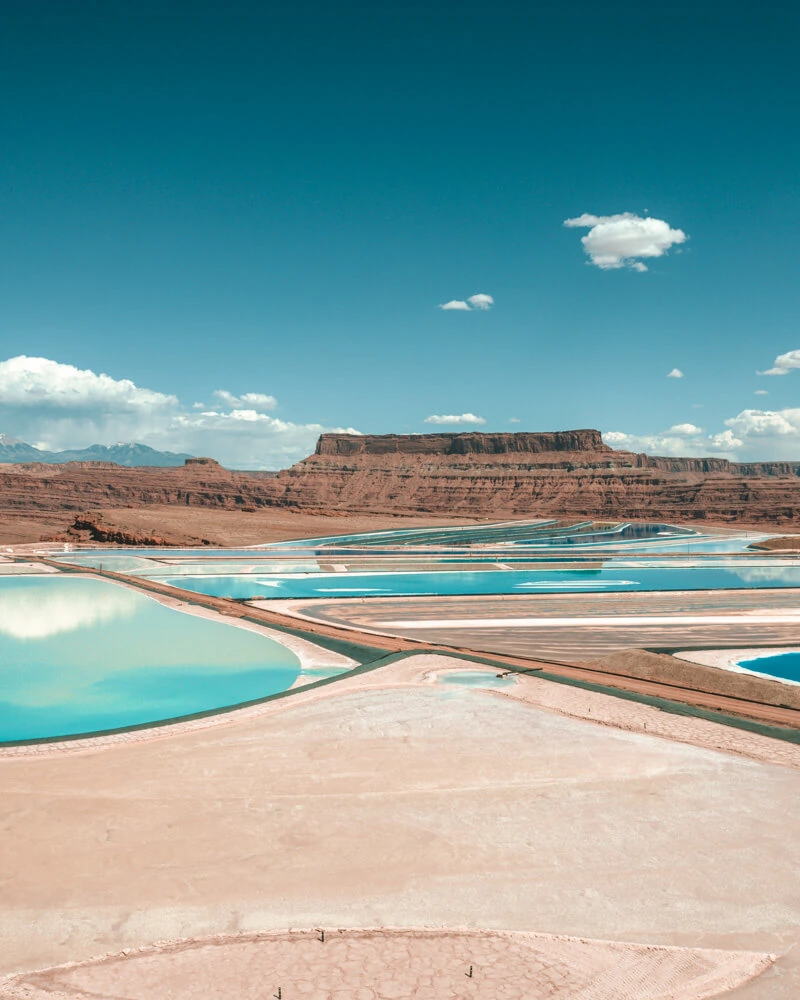
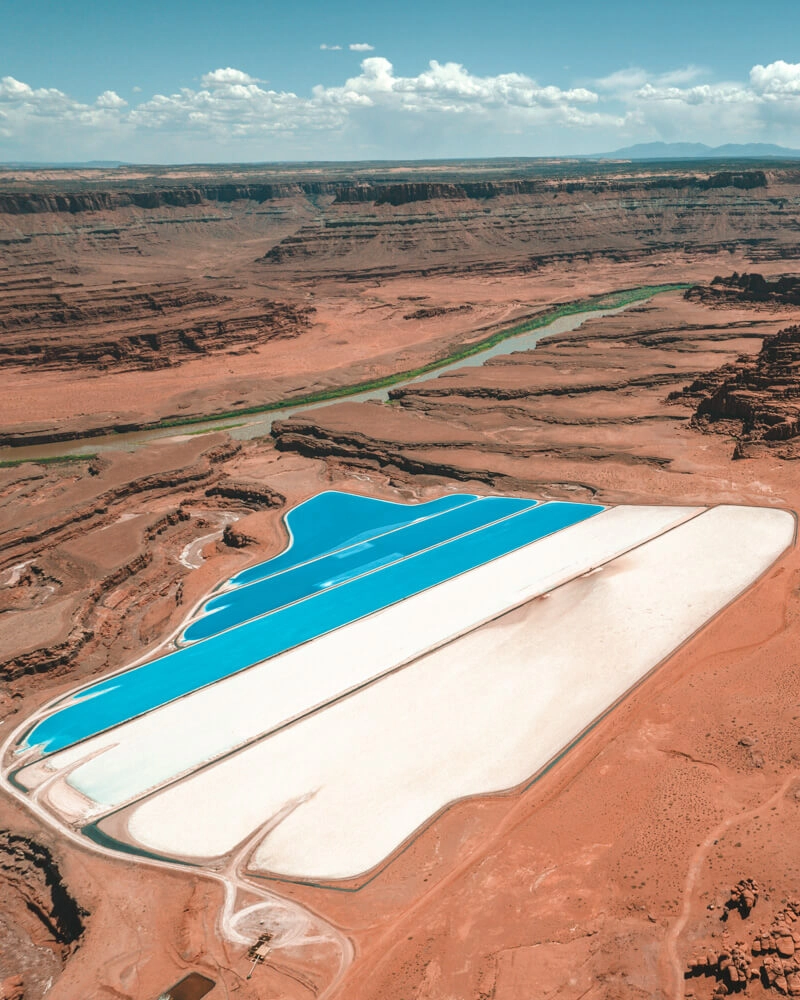
Can You Swim in Potash Ponds?
This is one of the more often asked questions, so I thought I would quickly address it here. No, you cannot swim in the potash ponds. These ponds are not swimming pools and are on private property. There are “No Trespassing” signs posted everywhere to keep people from attempting to get to the ponds. I can’t imagine it would be good for your body to swim in that much potash brine and dye either.
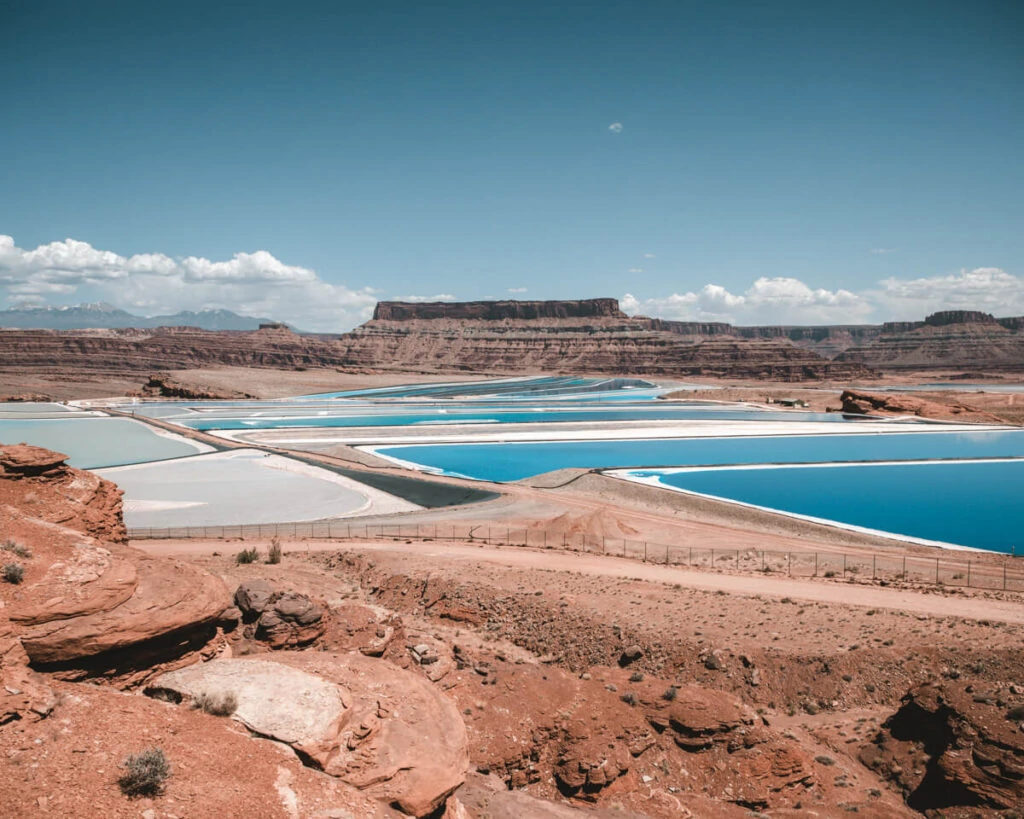
Where to Stay in Moab
If you are planning to stay a few days in Moab, we stayed at the Scenic View Inn & Suites Moab (Agoda | Booking.com) and enjoyed our time there. It is a little bit past downtown Moab, and it is on the opposite side of Moab from the national parks and potash ponds. We enjoyed being in a quieter area, and it did not add much time to the drive.
If you are looking for other options for places to stay in Moab, you can see what is available on Agoda here and on Booking.com here.
The best thing about Scenic View Inn & Suites Moab was how close it was to our favorite spot to eat in Moab, the Moab Brewery. We loved everything we ate there and stopped by one more time on our way out of town. If you like wings, they have some really good ones.
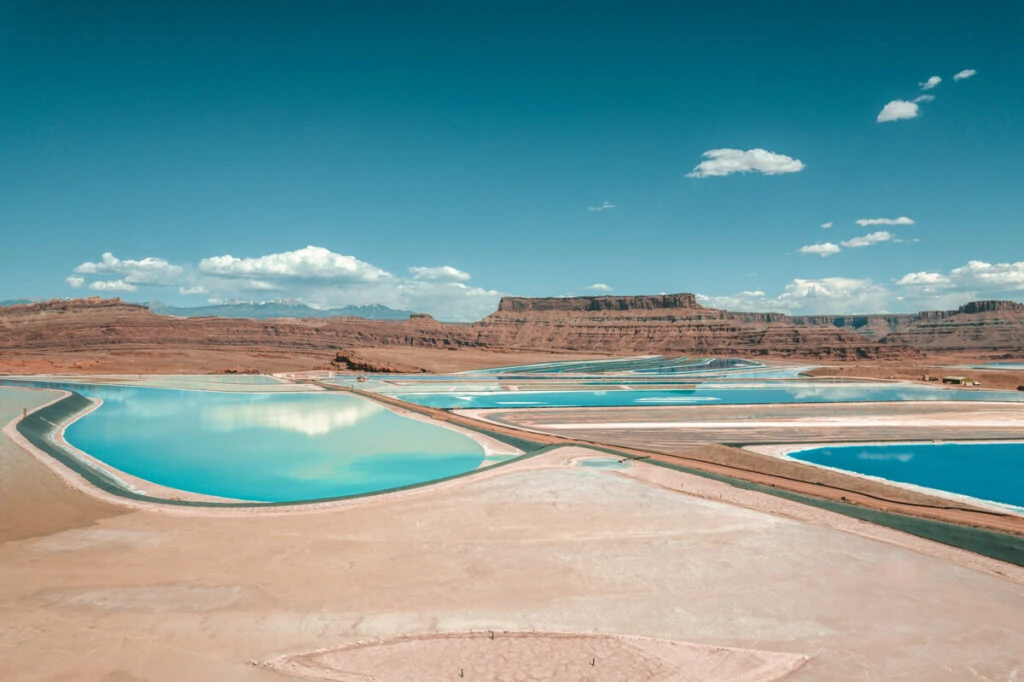
Are the Potash Ponds Worth a Visit?
If you have time on your trip, try to take a trip out to see the Texas Gulf potash ponds. It is a little bit of a drive from Moab but easily doable in a couple of hours with stops. If you plan to visit Canyonlands National Park or Dead Horse Point State Park, it is easier to reach on the way to or from either of those popular spots.
I really enjoyed seeing the bright blue ponds in the middle of the desert in Utah, so I would recommend them. They are one of the more unique things to do near Moab, and it is always nice to see something new. Places like this are why Utah is one of our top destinations you need to visit.
This was our third time to Moab, and I had not heard of these ponds before. I’m glad they had pictures of them on the wall at the hotel or I would not have known to look for them.
If you are looking for other uniques places to go in Southern Utah and Northern Arizona, check out the Bentonite Hills, the Great Chamber near Kanab, Utah, or White Pocket, Arizona.
LIKE THIS POST? PIN IT FOR LATER AND SHARE IT WITH OTHERS!
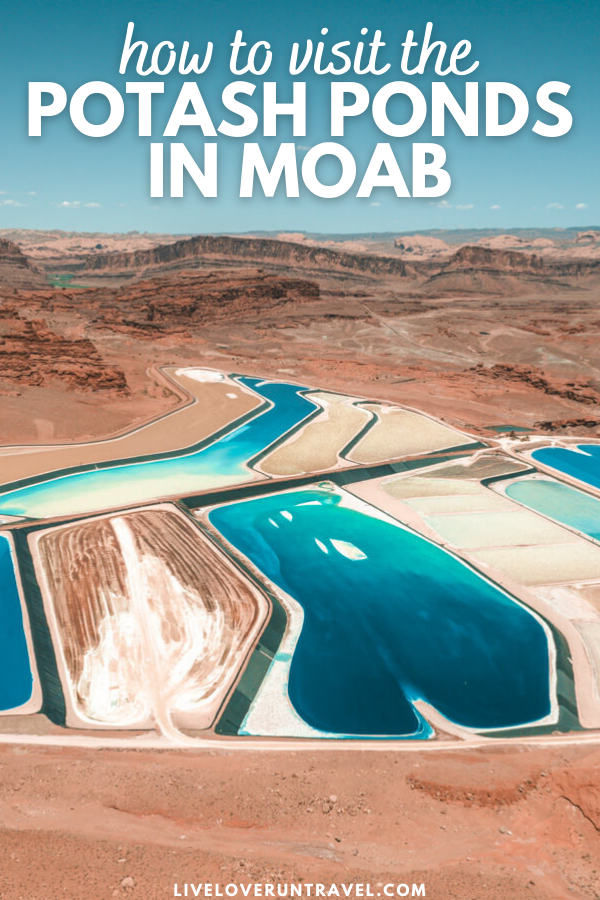

Matteo-sama
Monday 15th of November 2021
You should maybe alert people to this fact in your swim warning section.
Potassium salts like KCL are used in "humane" lethal injections, where legal. Lethal exposure causes dysrhythmias which will effectively make your heart stop beating. The data points strongly suggest, "Historically excessive respiratory disease rates due to environmental hazards, such as radon and asbestos, silicosis is another credible threat." No swimming.
Great post. Thanks for the tips. It's hard getting local knowledge as an obscure traveler.
May the wind always be at your back and the sun upon your face. And may the wings of destiny carry you aloft to dance with the stars. ...George Jung
Christine Wheeler
Tuesday 7th of December 2021
I didn't know all of that, so thank you for adding that value. Thankfully they have large fences around the part along the road (all of it if I'm remembering correctly), so it makes it hard for people to get to them to try to swim. There is always someone who will want to climb the fence for a picture floating in them though, so it's good to know the consequences. I'll have to update that when I get a chance this week.